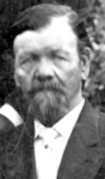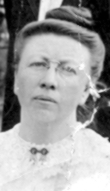
Bestafa Munson had a bewiskered face in a massive head set on massive shoulders. He was as strong as an ox. He spent the early part of his life as a ship’s carpenter, sailing the deep blue sea.
On fishing boats, he made many trips to the Lofoton Island fishing grounds. It was a cold, dangerous, and rough sea in the Lofoton, off northern Norway.
He tells of one voyage when a sudden storm caught the fishing fleet with howling winds and raging seas. They all dropped anchor and trimmed sail. It became as black as night..
Most of the anchors held, but many didn’t. He could hear the screams and prayers of the men being swept toward the rocky shore as they dragged by his boat..There was no way that they could provide help. He and his shipmates prayed aloud for their own and the others survival. There were no atheists in that fleet of worried men.
Bestafa was my father’s father, my paternal grandfather. He came to America and worked as a carpenter until he had saved enough to send for his family. He had rented a modest home in Brooklyn. He had a big family.
It was a great day when his family arrived at Ellis Island (MMP: not in use then. 1884 KMC: it was Castle Garden) The family consisted of Bestafa, Bestamor, (MMP: Inge), Christian, Andrew, John, Lawrence (My dad), Alfred, Gertrude, and Josie. Bestafa guided them to the nearby subway station. It was frightening and exciting. The noisy subway train took them under the river to Brooklyn. ( MMP: correction: Subways were not in use in New York until 1904. Dad remembered a long walk in heavy clothing under a hot July sun. KMC see LJM letters for description of the ferry ride and walk ) They walked a few blocks to their new home. The children were excited, they had to see everything. It was all so new. They lived there until Bestamor died, and Bestafa went to live with Aunt Gertrude who had a fine secretarial position in Manhattan.
I remember one time that Bestafa took me on a subway trip. He held my hand so protectively tight that it was painful. He was a powerful man with wide shoulders and a barrel chest. I remember praying that I would have his strength, and Dadda’s quick mind.
Bestafa built the bathrooms for both the upper and lower cottages in Cragsmoor. He also did some work at 357 Ovington Avenue, in Bay Ridge, Brooklyn, where Dad and Mother had purchased a large three story house for a Music School, and for our residence, in 1916. My Dad used to tell the story about his mother in Norway, on the waterfront where they had their home. The children were in bed for the night. Bestafa was somewhere at sea.

Some waterfront rowdies had obviously been drinking. Their loud talk could be heard in the house. They stopped right in front of the house. They could be heard discussing the woman who lived there. They approached the front door. It was locked.
Hearing them, Bestamor called out in a loud voice, "Christian, John, Alfred, Andrea, Lawrence, better come down here before we have some noisy visitors." The rowdies quickly disappeared into the night.
Dad had a harmonica as a boy. Even then he evinced his destiny. His mother told him to play some nice church music on his harmonica, so the non-church going neighbors would at least hear part of a church service.
Frequently his mother would send him to his aunt, "Tante ( MMP: Ida )" on an errand of some kind. He hated to go, not knowing what kind of a reception he would get. Sometimes when he rang her doorbell she would come to the door and say, "Humph, If I’d known it was you I wouldn’t have bothered."
Other times she would show much affection, and invite him in for tea. She would pour the tea and then say, "I hope it is warm enough," and she promptly plunged her thumb into his cup of tea. "I always had trouble drinking the tea after that," Dad would tell us.
Bestafa had an accident on a trolley car when he was 80 years old. The trolley was an open trolley with a long running board on the right side running from front to back of the car. Similar to the cable cars at San Francisco with the motorman in front.
The car was not crowded. It was early afternoon. Bestafa sat in a seat near the right side. It was a long seat that reached from side to side without any aisle.. The car was moving pretty fast. Perhaps it was the motorman and conductors last trip of the day. The car hit a switch too fast and jumped the track. Bestafa was thrown out of the car. He landed on his head and shoulder.
The conductor ran to help him up and to find out if he was hurt.
Bestafa just got up shook himself decided to walk the last few blocks. "I’m all right," he told them, as a crowd began to gather. He died several years later, and only then did the doctors discover that he had suffered a broken skull. However his eyesight and hearing began to fail after that.

My Dad told some amusing stories about his sister Inge, who lived on Staten Island. She had five children – Christie, Jenny, Louise, Nancy, and Agnes. She was on the heavy side and ruled her family with an iron hand. And she was a teetotaler.
She would visit us from time to time. One winter day when she visited us, she decided to walk down to Third Avenue to the grocery store to buy a bottle of vinegar. The sidewalks were icy and she slipped and fell after leaving the store with her bottle of vinegar. Afraid that people trying to help her up would see the bottle and think that she had been drinking, she held up the broken bottle and said, "Smell, smell."
Another time while driving with Dad in his Studebaker and he had stopped for gasoline, she asked, "Did we come here to change gears?"
She had a big heart, and when we visited her on Staten Island she always served a sumptuous meal with many cookie and cake delicacies. One time Christie took me for a sail in an outrigger canoe, off the sandy beach. That was exciting fun.
| Return to Munson home page |
Copyright © 2001 Kitty Cooper